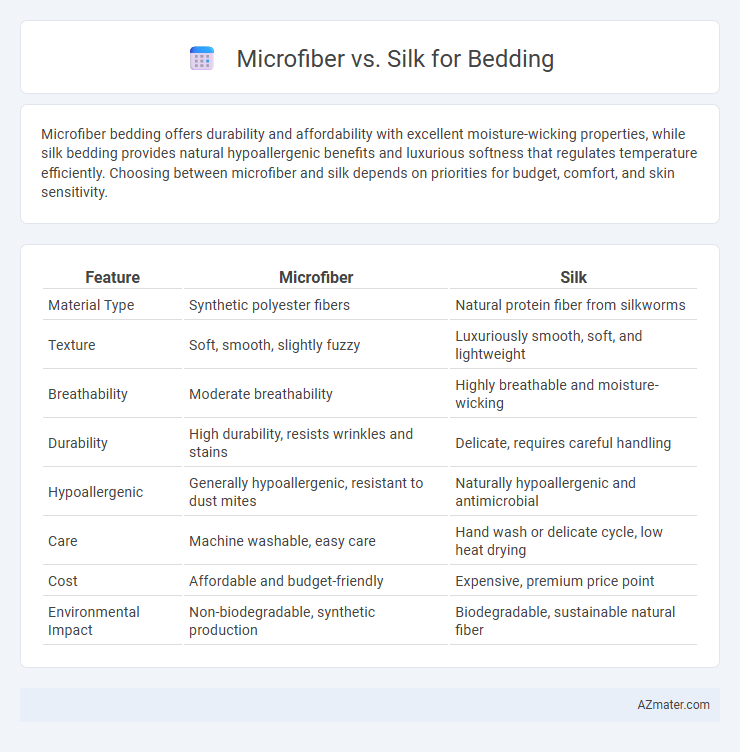Microfiber bedding offers durability and affordability with excellent moisture-wicking properties, while silk bedding provides natural hypoallergenic benefits and luxurious softness that regulates temperature efficiently. Choosing between microfiber and silk depends on priorities for budget, comfort, and skin sensitivity.
Table of Comparison
| Feature | Microfiber | Silk |
|---|---|---|
| Material Type | Synthetic polyester fibers | Natural protein fiber from silkworms |
| Texture | Soft, smooth, slightly fuzzy | Luxuriously smooth, soft, and lightweight |
| Breathability | Moderate breathability | Highly breathable and moisture-wicking |
| Durability | High durability, resists wrinkles and stains | Delicate, requires careful handling |
| Hypoallergenic | Generally hypoallergenic, resistant to dust mites | Naturally hypoallergenic and antimicrobial |
| Care | Machine washable, easy care | Hand wash or delicate cycle, low heat drying |
| Cost | Affordable and budget-friendly | Expensive, premium price point |
| Environmental Impact | Non-biodegradable, synthetic production | Biodegradable, sustainable natural fiber |
Understanding Microfiber and Silk Bedding
Microfiber bedding consists of finely woven polyester fibers known for durability, stain resistance, and moisture-wicking properties, making it a budget-friendly and low-maintenance option. Silk bedding, derived from natural silk protein, offers a smooth, hypoallergenic surface with temperature-regulating benefits that promote skin and hair health. Understanding these key material differences helps consumers choose between microfiber's practicality and silk's luxury for optimal sleep comfort.
Key Differences Between Microfiber and Silk
Microfiber bedding is made from synthetic fibers like polyester, offering durability, wrinkle resistance, and affordability, while silk is a natural protein fiber known for its luxurious softness, breathability, and hypoallergenic properties. Microfiber excels in moisture-wicking and stain resistance, making it ideal for easy maintenance, whereas silk regulates temperature effectively, keeping sleepers cool in summer and warm in winter. The key differences lie in texture, breathability, durability, and care requirements, with microfiber requiring less delicate washing compared to the gentle, often dry-clean-only treatments needed for silk.
Comfort and Softness Comparison
Microfiber bedding offers exceptional softness with a smooth, lightweight texture that maintains warmth and moisture-wicking properties, making it ideal for year-round comfort. Silk bedding provides a luxurious, natural softness that is hypoallergenic and breathable, keeping sleepers cool in summer and warm in winter. While microfiber excels in durability and affordability, silk stands out for its smooth, skin-friendly feel and temperature-regulating benefits.
Durability and Longevity
Microfiber bedding, composed of densely woven synthetic fibers like polyester, offers exceptional durability and resistance to wear, fading, and shrinking, making it ideal for frequent use and easy maintenance. Silk bedding, crafted from natural protein fibers produced by silkworms, provides a delicate, luxurious feel but requires careful handling to prevent damage, with a shorter lifespan under regular use compared to microfiber. Over time, microfiber retains its color and structural integrity better than silk, making it a more practical choice for long-term durability in bedding applications.
Breathability and Temperature Regulation
Microfiber bedding offers moderate breathability with synthetic fibers that trap heat, making it less suitable for hot sleepers. Silk bedding excels in temperature regulation due to its natural protein fibers that wick moisture and allow for superior airflow, keeping users cool in summer and warm in winter. The moisture-wicking properties and lightweight texture of silk ensure optimal comfort, whereas microfiber tends to retain heat and moisture, impacting breathability negatively.
Hypoallergenic Properties
Microfiber bedding is highly valued for its hypoallergenic properties, as its tightly woven fibers resist dust mites, mold, and allergens, making it ideal for allergy sufferers. Silk, naturally hypoallergenic and resistant to dust mites, also offers moisture-wicking and temperature-regulating benefits, reducing the potential for allergen buildup. Both materials provide excellent options for sensitive skin, but microfiber tends to be more affordable and durable while silk offers a luxurious feel with natural antimicrobial properties.
Maintenance and Care Requirements
Microfiber bedding requires simple maintenance with machine-washing in cold water and low-heat drying, making it resistant to wrinkles and quick-drying. Silk bedding demands delicate care, including hand washing or dry cleaning and avoiding harsh detergents to maintain its natural fibers and sheen. Regular use of gentle, pH-neutral detergents and air drying are essential for prolonging silk's lifespan and preserving its luxurious texture.
Eco-Friendliness and Sustainability
Microfiber bedding, made from synthetic polyester fibers, typically requires significant energy and water in production, contributing to environmental concerns due to its non-biodegradable nature and potential microplastic pollution. Silk bedding, derived from silkworm cocoons, is biodegradable and renewable, with natural properties that reduce the need for harmful chemical treatments, promoting greater sustainability. Choosing silk supports eco-friendly practices through its organic cultivation, while microfiber often prioritizes cost over environmental impact.
Cost and Value for Money
Microfiber bedding offers an affordable price point while providing durability and ease of maintenance, making it a cost-effective choice for budget-conscious consumers. Silk bedding commands a higher price due to its natural fibers, luxurious feel, and hypoallergenic properties, delivering superior comfort and long-term value despite the initial investment. Evaluating cost versus longevity and comfort helps determine the best value for money between these materials.
Which Bedding Material Should You Choose?
Microfiber bedding offers affordable durability, easy maintenance, and moisture-wicking properties, making it ideal for allergy sufferers and budget-conscious buyers. Silk bedding provides natural temperature regulation, hypoallergenic benefits, and luxurious softness, suitable for sensitive skin and those seeking a premium sleep experience. Choose microfiber for practicality and cost-effectiveness, or opt for silk to enjoy an elegant feel and superior comfort.

Infographic: Microfiber vs Silk for Bedding
 azmater.com
azmater.com